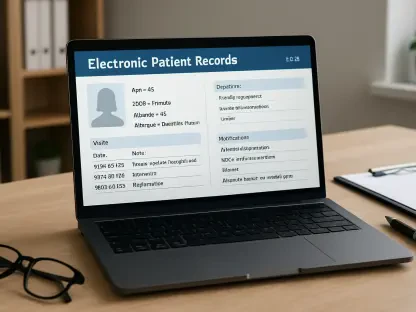Imagine a simple misstep on a patch of ice turning into a financial nightmare with a medical bill nearing $100,000 for a broken arm—a reality that Deborah Buttgereit, a 60-year-old widow from Bozeman, Montana, faced after a devastating fall that highlights the harsh realities of healthcare costs in the United States. Her story is not just a personal tragedy but a stark illustration of the crippling costs of healthcare, particularly for those without insurance. A single injury, a distal humerus fracture near the elbow, spiraled into a $97,998 bill for necessary surgery, later adjusted to $78,398.40 with a self-pay discount. This staggering figure raises pressing questions about how medical expenses can escalate so dramatically for something as seemingly routine as a broken bone. Beyond the numbers, her experience exposes systemic flaws in pricing transparency, the vulnerability of the uninsured, and the daunting barriers to challenging unfair charges. This narrative serves as a window into a broader crisis, where one accident can lead to a lifetime of debt for many Americans.
The Shocking Unpredictability of Medical Costs
Deborah Buttgereit’s case starkly reveals the unpredictable nature of medical expenses, a challenge that catches many patients off guard. Initially, Bozeman Health provided an estimate of $50,560 for what was expected to be a straightforward outpatient surgery to repair her fractured arm. However, during the procedure, surgeons discovered the bone was shattered into far more fragments than anticipated, compounded by nerve damage that demanded additional intervention. These unforeseen complications nearly doubled the final bill to $97,998, demonstrating how little control patients have over such outcomes. For someone without insurance, this unpredictability transforms a health crisis into a financial catastrophe, as there’s no buffer to absorb the escalated costs. The lack of certainty in pricing means that even with an estimate in hand, the final amount can be a shocking surprise, leaving individuals scrambling to address a debt they never saw coming.
This issue of unpredictability extends far beyond one patient’s story and reflects a systemic problem in healthcare cost estimation. Many individuals, particularly those uninsured, find themselves blindsided by bills that soar past initial projections due to complications that couldn’t be foreseen. Hospitals often include disclaimers that costs may rise, but these warnings do little to prepare patients for the reality of doubled or tripled charges. The absence of a mechanism to cap or predict these increases places the full burden on the patient, regardless of their ability to pay. In Deborah’s situation, the jump from an estimated $50,560 to nearly $98,000 underscores a critical gap in how medical pricing is communicated and managed. This unpredictability fuels distrust in the system, as patients are left vulnerable to financial ruin over health issues that are already distressing enough without the added weight of exorbitant costs.
Vulnerability Without Insurance Coverage
The absence of health insurance left Deborah Buttgereit exposed to catastrophic financial consequences, a plight shared by countless others in similar circumstances. After her husband’s sudden death, she stepped away from her job due to emotional distress, losing employer-provided coverage in the process. Although she temporarily secured a subsidized plan through a government marketplace, the high cost of living in Bozeman, coupled with a limited income from Social Security and part-time work, forced her to let it lapse just months before her fall. This left her with no safety net when the accident occurred, turning a painful injury into a nearly $98,000 debt. Her story highlights how easily coverage can slip through one’s fingers due to life’s hardships, leaving individuals at the mercy of a healthcare system that often prioritizes cost over accessibility.
Being uninsured amplifies the impact of medical emergencies in ways that are both immediate and long-lasting. Without the protection of insurance to negotiate rates or cover a portion of expenses, patients like Deborah face the full brunt of hospital charges, which are often inflated compared to what insured individuals might pay. The loss of coverage, whether due to personal tragedy or financial strain, creates a precarious situation where a single incident can lead to insurmountable debt. In this case, the lack of a safety net meant that a broken arm became a life-altering burden, with monthly payments of $100 stretching repayment over decades. This vulnerability underscores a broader issue in the U.S. healthcare landscape, where millions remain one accident away from financial devastation, lacking the resources or support to navigate the aftermath of unexpected medical needs.
Navigating the Maze of Medical Billing
The complexity and opacity of medical billing practices added a layer of frustration to Deborah Buttgereit’s already daunting situation. Struggling to comprehend why her surgery cost jumped from an estimated $50,560 to nearly $98,000, she found the initial projection questionable when compared to online benchmarks for similar procedures, which ranged between $8,000 and $40,000. Interactions with Bozeman Health’s billing department only deepened her confusion, as she received inaccurate information about her rights under protective legislation and the deadlines for disputing charges. This lack of clarity left her feeling powerless, unable to decipher the breakdown of costs or challenge what seemed like an inflated bill. The experience points to a critical flaw in how pricing information is conveyed, often leaving patients in the dark about the true nature of their financial obligations.
Beyond the personal impact, the broader trend of convoluted medical billing practices affects countless individuals seeking transparency in healthcare costs. Hospitals frequently present itemized bills that are difficult to interpret, with charges for operating room time, supplies, and other services often appearing disproportionate to the care received. In Deborah’s case, over $44,000 was attributed to operating room fees and more than $50,000 to medical supplies, figures that seemed exorbitant without detailed justification. Miscommunications, such as incorrect guidance on legal protections, further complicate efforts to contest charges. This systemic lack of straightforward information erodes trust and places an undue burden on patients, particularly the uninsured, who must navigate this maze without the benefit of insurance advocates or resources to assist in understanding or disputing the costs they face.
Challenges in Seeking Recourse for Unfair Charges
When it came to challenging her staggering medical bill, Deborah Buttgereit found her options limited and the process intimidating. Initially, she resisted applying for financial aid from the hospital, believing that doing so would imply acceptance of a charge she deemed unfair. Instead, she discovered a lesser-known provision under the No Surprises Act, which allows uninsured patients to dispute bills that exceed initial estimates by $400 or more. However, hesitation set in due to uncertainties about the dispute process and the fact that even the original estimate felt excessively high. This reluctance illustrates how even well-intentioned protective measures can seem out of reach for those overwhelmed by both medical recovery and financial stress. The barriers to accessing recourse often deter patients from pursuing the relief they desperately need.
The struggle to find effective recourse is a common theme for many facing exorbitant medical costs, particularly among the uninsured. While legislative tools like the No Surprises Act offer a potential pathway to contest unfair billing, the complexity of navigating these processes can be a significant obstacle. Patients must often contend with bureaucratic hurdles, tight deadlines, and a lack of clear guidance on how to proceed, all while grappling with the immediate pressures of debt. In Deborah’s situation, the hospital offered an additional $7,000 discount tied to a payment plan, but this did little to alleviate the overall burden. The broader challenge lies in making these protective mechanisms more accessible and user-friendly, ensuring that individuals are not deterred by the daunting nature of the system. Without streamlined support, many risk accepting inflated bills out of sheer exhaustion or fear of further complications in their efforts to fight back.
Systemic Flaws in Healthcare Affordability
Deborah Buttgereit’s ordeal serves as a microcosm of the larger crisis of healthcare affordability plaguing the U.S. system. There’s a growing recognition that medical costs often bear little relation to the actual services rendered, driven by factors such as hospital pricing models, unexpected complications during treatment, and a profound lack of transparency. Pre-surgery cost estimates, intended as a tool for patients to plan financially, frequently fall short by failing to account for potential issues that arise mid-procedure. For the uninsured, this discrepancy can be particularly devastating, as they lack the negotiated rates or coverage buffers that insured patients might benefit from. Her nearly $98,000 bill for a broken arm repair underscores how a single health event can push someone into financial ruin, reflecting a systemic issue that affects millions across the country.
Addressing the root causes of healthcare affordability requires confronting entrenched practices that prioritize revenue over patient well-being. The consensus among advocates is that pricing transparency must improve, with hospitals providing clearer, more accurate estimates that consider a range of possible outcomes. Additionally, the disparity between what insured and uninsured patients pay for identical procedures highlights a need for fairer billing standards. Deborah’s experience, where complications inflated costs beyond any reasonable expectation, points to the urgency of reforms that protect vulnerable populations from bearing the full weight of systemic inefficiencies. Until such changes are implemented, stories of exorbitant medical bills will continue to emerge, each one a reminder of a system that often fails to prioritize accessibility and equity in care, leaving many to navigate a landscape of debt and uncertainty after even routine injuries.
Legislative Protections and Persistent Barriers
The introduction of the No Surprises Act in 2022 marked a significant step toward shielding patients from unexpected medical costs, offering provisions that allow uninsured individuals like Deborah Buttgereit to dispute bills that far exceed initial estimates. This legislation provides a glimmer of hope by creating a formal process to challenge charges, particularly for non-emergency procedures where costs spiral due to unforeseen complications. However, the effectiveness of this protection is often undermined by a lack of public awareness and the complexity of the dispute mechanism. Many patients remain unaware of their rights or find the process too cumbersome to navigate during a time of physical and financial strain. This gap between policy intent and practical application reveals a critical area for improvement in supporting those most at risk.
Efforts to strengthen legislative protections must focus on education and accessibility to ensure they serve their intended purpose. In Deborah’s case, it was only after reaching out to federal resources, including guidance from the Centers for Medicare & Medicaid Services, that she felt equipped to pursue a formal dispute. This highlights how external support can make a difference, yet it also shows that such assistance is not readily available to everyone. Streamlining the dispute process, coupled with proactive outreach to inform patients of their rights under laws like the No Surprises Act, could empower more individuals to challenge unfair billing. Until these barriers are addressed, protective measures risk remaining underutilized, leaving countless patients to grapple with inflated costs without a clear path to relief. Bridging this gap is essential to transforming well-meaning policies into tangible safeguards for the uninsured.
Resilience in the Face of Financial Hardship
Despite facing a reduced but still overwhelming debt of $78,398.40, Deborah Buttgereit’s determination to fight back against her medical bill reflects remarkable personal resilience. Agreeing to a $100 monthly payment plan that could take decades to clear, she refused to simply accept the burden as inevitable. Instead, after persistent efforts, including outreach to the White House for assistance, she gained crucial guidance from federal health agencies and decided to pursue a formal dispute under the No Surprises Act. Her resolve to challenge the charges, even in the face of systemic obstacles, underscores the individual grit required to navigate a healthcare landscape that often feels indifferent to patient struggles. This tenacity serves as a powerful reminder of the importance of advocacy when confronting seemingly insurmountable financial challenges.
The broader implications of such resilience highlight a dual reality within the healthcare system: while personal determination can drive change, it also reveals the flaws that necessitate such effort in the first place. Deborah’s journey—from a painful injury to a staggering bill and finally to a decision to contest it—demonstrates that patients often must become their own advocates, seeking out resources and information that should be more readily provided. Her story also points to the need for systemic support to bolster individual efforts, ensuring that fighting for fairness doesn’t remain an uphill battle fought alone. As more patients take similar steps to dispute unfair charges, their collective actions could pressure hospitals and policymakers to prioritize transparency and affordability. Until then, personal perseverance remains a critical tool for those caught in the crosshairs of medical debt, pushing against a system slow to reform.
A Call for Systemic Change and Patient Empowerment
Reflecting on Deborah Buttgereit’s experience, it’s evident that her struggle with a $97,998 medical bill after a broken arm captures a critical failure in the U.S. healthcare framework. Her battle exposed how unpredictable costs, opaque billing, and limited recourse trap countless individuals in cycles of debt. The interventions she sought, from federal guidance to invoking legislative protections, showed that while paths to challenge such burdens exist, they are fraught with complexity and inaccessibility. Her decision to dispute the charges marked a stand against a system that often overwhelms the uninsured with little regard for their financial survival.
Looking ahead, the focus must shift toward actionable reforms that prevent such stories from recurring. Hospitals should enhance pricing transparency by offering detailed, realistic estimates that account for potential complications. Policymakers need to simplify and promote dispute processes under laws like the No Surprises Act, ensuring patients can access relief without exhaustive effort. Empowering individuals with tools to compare costs before treatment and clear guidance post-treatment could mitigate the shock of inflated bills. Ultimately, systemic change paired with patient education offers the best hope to transform a landscape where a single injury no longer equates to a lifetime of financial hardship.









